

Time is the thread that stitches together so many stories, and to travel to the future, first we must go back to the past...
The year is 1894, in what is now the Czech Republic but, at this time, was part of the Austro-Hungarian Empire. In the province of Boehmen, Anton Schneider and W John produce hand-made cycle parts on lathes and bench vices, which they distribute to customers on their own home-built bicycles. Bikes are in popular demand, business goes well, and the partners formally establish a company at Oberpolitz in Sudetenland. They call the company Achilles.
Progressing from bicycle manufacture, in 1906 the firm also tried its hand at building motor cycles with 3.5hp single cylinder and 5hp V-twin proprietary engines by Fafnir and Zeus. Motor cycles were discontinued after 1912 and progressive expansion of the business slowed during the resulting difficulties of the First World War. It resumed, again with bicycles, as trade picked up after the armistice.
In 1920, Schneider's son-in-law Ernst Weikert joined the company, bringing in a fresh spirit, which resulted in rising production figures and significant expansion. By 1937, three subsidiaries had been created, and Achilles had grown to employ up to 2,700 people before the end of the decade.
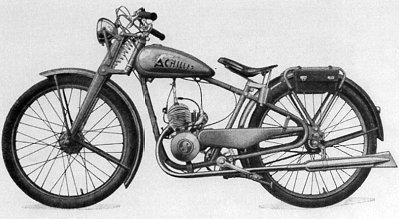
1938 Achilles Modell 98
An Achilles Modell 98 autocycle with a 2-speed Sachs motor was introduced in 1938, being characterised by its corporate light green colour scheme and wide, comfortable saddle. Much promotional attention was gained by Franz Münnich's tour to Africa on one of these models, the 5,000 kilometre trip through Italy, to Tunisia and Libya effectively proving the reliability of the small Sachs engine.
Cycle production abruptly ended with the dispossession of works under the occupation of Bohemia in 1939, and the subsequent annexation of Czechoslovakia.
It's possible that recovery of whatever may have remained from the original works was caught up among the post-war mass expulsions of German nationals, or Ernst was attracted by the economic upswing following World War 2, but the business relocated to West Germany and started construction of a new plant in a former barracks at Wilhelmshafen-Langewerth. After a year building up the new factory, production had barely started before a devastating fire destroyed the whole site in December 1948.
Achilles started again, rebuilding the plant, investing in new equipment, and contracting Swiss design engineers in collaboration with Walter Haefner Holding AG, to produce a series of successful and stylish Roller motor cycle/scooters, its first A7 moped from 1953, and followed by development of the rigid frame Capri moped.
The attractive design of the Capri Luxus for 1955 widely appealed to lots of moped customers, and opened market opportunities for Achilles across many European countries. Production increased six-fold, and AMI, Germaan, Empo, Union, and others also sold licence-branded versions. Motor options initially included Zündapp and Ilo, but by year's end, the Sachs 2-speed had become the favoured choice.
At the Earls Court Motor Cycle Show in November 1955, a small English company introduced its pretty new Norman Nippy moped with 1.25bhp Sachs engine - it was of course, nothing other than another factored branding of the Mark 1 rigid-frame Achilles Capri. Norman even employed Achilles' very own colour photosets for their early promotional literature!
By 1956, the resurrected Achilles Company registered 500 employees, and listed 2,500 dealers across Germany, though now the Swiss company Haefner had acquired 95% of the business and changed the wage structure to piece-working. In February 1956, Haefner planned to continue expansion and wanted to build extended production facilities onto the yard of the Nordwestdeutschen Fahrzeugbau (which had become available as this business suffered bankruptcy in 1955), but the authorities were unco-operative, and Haefner responded by proposing to relocate to the south of Germany.

Moped of the Future?
In October 1956 at the Cologne IFMA (Internationale Fahrrad und Motorrad Ausstellung), Achilles unveiled a most inspired creation, advertised as their "Moped of the Future" - the Lido introduced a revolution of modern science fiction styling. The handlebar instrument panel is built to house both the speedometer and an optional clock, while inverted levers, cursor throttle and twistchange neatly route all cables within the shell. The rear carrier is styled into the press-formed frame, and can be topped with a single saddle or Denfeld dual seat, folded up from the front to access a lockable tool tray.
The smooth look steel side panels extend forwards to shroud the engine in a cowl, inset with cast aluminium grids to ventilate the cylinder. The 'caged engine' look had previously appeared on the peculiar Commander prototype range by General Steel & Iron, that were shown as models at Earls Court in 1952, though failed to go into production.
With the trend-setting design lines of the Lido, Achilles introduced an imaginative new space-age look and inspired a mini styling revolution as other manufacturers subsequently sought to emulate the image.

Centro Planeet
Following the popularity of the first Nippy moped, Norman introduced the Mark 2 Nippy (based on the Achilles Capri plunger frame version) at Earls Court in November 1956, and followed by de-listing the original rigid frame Nippy Mark 1 model in January 1957. By this time, the fitted Sachs motor had progressed up to a 1.6bhp rating.
The Achilles Lido was also sold in Holland, as another branded version called the Centro Planeet.
First announced in the UK on 7th February 1957, Motor Cycling very briefly described the Achilles Lido as a 2-speed moped, in two-tone green, with Curry's appointed as concessionaires. Another brief note appeared in The Motor Cycle of the following week, quoting a price of £78-15s-0d, and accompanied by a black & white news picture of a single-seat machine with a light coloured frame and darker tank.
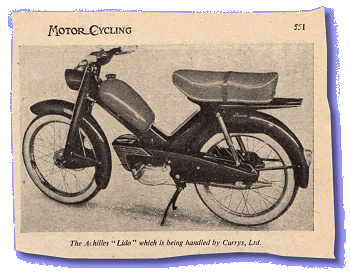
Lido picture in Motor Cycling
Then on 21st February, another small feature in Motor Cycling covered the official launch of the 'streamlined' German Achilles Lido and its introduction at a reception held last Thursday (14th February 1957) at Browns Hotel, London W1, by Curry's Cycle and Accessory Dealers (more recently known as electrical retailers), who were handling imports and distribution across Britain through their 270 branches. The accompanying picture illustrated the Lido as a dual-seat machine with dark frame and a lighter tank, chrome rims, whitewall tyres, and clearly installed with a quite recognisable 3-speed Sachs engine! Price again repeated at 75 guineas.
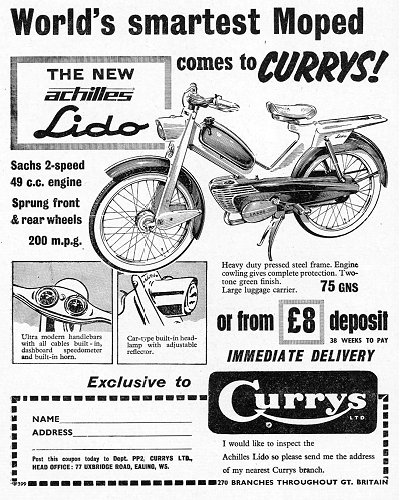
Achilles Lido advert in Power & Pedal
Power & Pedal carried a similar announcement with full-page advert in March 1957, and featured a road test on the Achilles Lido in the April edition, again accompanied by a full-page advert, everything describing it as having a 2-speed motor, and priced at 75 guineas.
As it turned out, "The Moped of the Future" didn't seem to have a future! The promising prospects of the early 1950s descended into the nightmare of a sales slump in the second half of the decade. As people across Europe became more affluent, demand for motor cars increased, while interest in bikes plummeted, with the resultant closure of numerous two-wheel manufacturers. This fall in business caught up with the earlier capital investments before the costs had become amortised, and Achilles filed for bankruptcy.
As part of the British Cycle Corporation since 1953, and backed by the finance of Tube Investments Group, Norman purchased the tooling and rights from Achilles' receivers, to continue moped manufacture for themselves. Back in Germany, the yard gates of Achilles-Werke in Langewerth were locked shut for the last time in 1958.
Though the last 'production' listing for the Achilles Lido appeared in November 1957, the 1958 April edition of Power & Pedal returned a full-page Curry's advert now offering the Achilles Lido reduced to 65 guineas! It seems that Curry's had acquired the remaining bankrupt stock to clear on the British market. Curry's repeated this practice a number of times with short-term offers of obscure mopeds as continental manufacturers fell upon hard times (Patria was another example).

Achilles Lido
Glass's Index indicates the Lido as 'imports discontinued in July 1958', but Power & Pedal kept listing Achilles in its Market Guide up to October 1958.
With Villiers's introduction of the 3K moped engine, Norman began reworking their models to incorporate this motor, showing a plunger frame Nippy Mark 2 with a Sachs engine, together with a new Lido 3K model in a staged press release at Lydd, Kent. The publicity appeared in Motor Cycling edition 9th October 1958, and seemed to be by mutual arrangement with the airline promoting an under-100cc crossing to the continent by Silver City Super-freighter from Ferryfield airport.
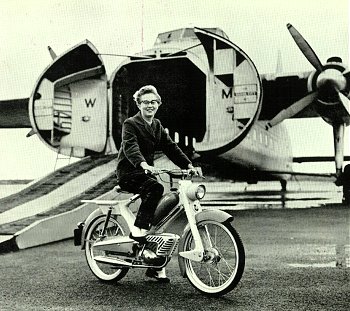
Silver City picture from Norman brochure
The following month found the Villiers 3K Norman Lido appearing at the Earls Court Motor Cycle Show, its price posted at £74-11s-0d, and pictures from the Silver City photoshoot featuring in Norman's sales leaflets for the coming 1959 season.
With the Villiers 3K engine now listed as standard installation for both Lido and Nippy models, and Norman still holding stocks and contractual commitments with Fichtel & Sachs, the Sachs motor continued to be offered as a 'special order' option in the Nippy Mark 2 and Lido for 1959 (POA).
With the arrival of the Villiers engine, cycle parts of the Norman Nippy Mark 2 were changed to produce a Type 2 variant. The Capri plunger frame was fitted with the complete Lido front end, comprising fork set, headlamp nacelle, front mudguard and handlebar console; the Lido rear mudguard was also fitted to match at the back and the earlier continental press formed chain guard was dropped for a plain bent steel plate.
On the Lido, the engine cowlings were modified into simple punched slots, deleting the inserted cast aluminium grids of the Achilles. It's unclear whether this change was made as a cost saving simplification, or from force of necessity as the alloy grid casting dies may not have arrived with the rest of the tooling set. Since Norman was now fitting Amal gearchange and throttle lever sets in place of the original inverted handlebar furniture, all of the cables were now exposed and routed outside the handlebar console.
Though the original Achilles design was becoming diluted, the Norman Lido was still a striking machine in its two-tone colour scheme, and the option of fitted clock for £1-19s continued to be offered among the list of sundries.
There was also a number of further adaptations of various fittings to suit British market parts, wheel hubs switched from Sachs to British Hub Company, the fuel filler neck and cap changed, and tank fitting converted from metric fitting to a 1/8 inch gas thread boss to accommodate an imperial Ewarts petrol tap.
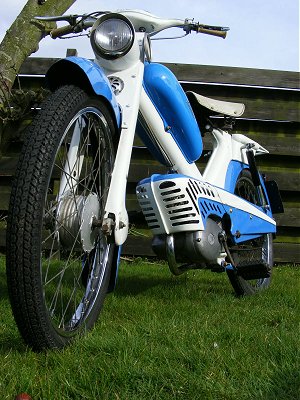
Our featured Villiers 3K powered Norman Lido wears frame serial A1274. Fuel turns on at the bottom right of the petrol tank, then press down the enrichment control [Norman call this carburettor primer comp. (Villiers) part number L07] to close the choke shutter. The Villiers SM12 carb is also equipped with the standard flood button, but this is completely inaccessible through the engine cowling, and there is no linkage fitted to operate it remotely. A couple of swings on the pedals soon rewards us with the engine firing, but premature opening of the throttle also disengages the choke, so the engine dies again. It takes a couple more attempts before we manage to keep our 3K motor running.
Pull in the clutch and twist forward for first, which locates with a clunk and a jolt. Lido nips smartly away as you buzz up the revs and feed out the clutch. Bottom gear allows a maximum of barely 15mph, but really asks to change up before this, at around 12mph, leaving second gear a big jump away as the motor struggles through a dead zone until 20mph when the revs start to pick up again.
Comfortable cruising is found around 25mph, with best on flat paced at 31mph. The downhill run squeezed our mount up to a maximum of 35mph, but it faded badly on the climb going up the other side and required a cog down to first to crest the rise in a miserable attempt that could have been bested by an asthmatic jogger.
It felt as if this motor was either overgeared for this challenge, or more likely, failing to deliver the full return of its 2bhp rating.
Handling & general ride were fine, and Lido continued safely in a straight line when trying hands free. Both brakes were quite good enough for the performance of the machine, though application of the front alone was a little distracting as the suspension rode up on its leading links. Creaky and squeaky suspension from both front and rear didn't serve to convey any particularly convincing impression of any revolutionary technological breakthrough that the styling may imply.
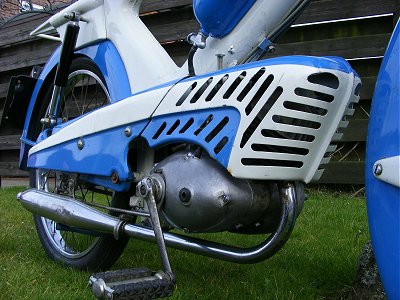
And does Villiers's latest electrical evolution of their new M2940C 6 Volt 17 Watt flywheel magneto generator flood the dark country lanes with a blaze of illumination from the 15 Watt headlamp? Click ... Er, no!
The reality of riding our Villiers 3K Lido might not have seemed quite like the science fiction, space-age experience we may have been hoping for ... it looks groovy, but still feels very much like riding an old moped!
As a review of its moped model range in preparation for the next year, Norman notified discontinuance of Sachs engine options for both the Nippy Mark 2 and Lido in September 1959. In October 1959 they notified discontinuance of the Nippy Mark 2 (Villiers 3K version), concluding that model. November 1959 then found Norman de-listing the Lido with Villiers 3K engine, with Glass's Index confirming that model only being available for one year.
It may have briefly appeared that Norman had discontinued its entire moped range, but just a few weeks later found the company announcing a selection of new models.
The Lido was re-launched as the new "Super Lido" in Burgundy Flamboyant & Cream 'Epinamel' colour scheme, and being installed with the Sachs 2.2bhp rated engine.
Norman had also converted the Lido frame press-tooling with interchangeable inserts to allow formation of a petrol tank integral in the spine. This option introduced two completely new Nippy models, the Mark 3 with bolted-on rigid rear frame section and sedentary MiVal automatic engine, and Mark 4 with swing-arm sprung rear frame and Villiers 3K 2-speed engine. Introduced in December 1959, this new range of models was more clearly defined and priced accordingly: Mark 3 £56-14s, Mark 4 £65-2s, and the Sachs 2-speed Super Lido appearing up to the end of November 59 at £72-3s.
Market charts from December 1959 to February 1960 confusingly suggest a 3-speed Sachs Norman Super Lido at £76-13s may have been planned, though no evidence appears that any such machine was put into production. Any proposed new 3-speed Lido looked as if it was probably cancelled before the sales season started, and March 1960 listings return to the 2-speed Super Lido priced at £76-13s.
Tube Investments Group's takeover of Raleigh Industries was finalised on 19th April 1960, and subsequently appointed Raleigh to head-up the group re-organisation of all the companies and products within the British Cycle Corporation.
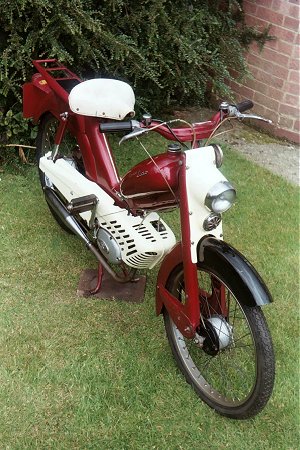
So here we are, now arrived in 1960, with the disillusionment of our 3K Lido firmly behind us, and the alluring promise of road testing our new Sachs 2-speed "Super Lido", frame number A2622. It says it's 'Super' so it's got to be better... Starting is slightly different from the earlier Villiers motor, as the 12mm Bing carb on the Sachs doesn't have any choke mechanism and requires the float chamber flooding to encourage the motor to fire. The flood function is remotely controlled through all the tin-ware, by a tickler extension [Norman call this 'carburettor primer comp. (Sachs) part number L08'], that stands by a cap located on the carb button. This rod emerges through a notch in the top of the left hand side panel, and is secured into position by a tag welded to the frame. One obvious difficulty is that you can't really see when the float chamber is overflowing, so liberal use to ensure the carb is properly flooded inevitably results in excessive petroiliness progressively accumulating in the depths of the engine bay, and leaving overflowing fuel dripping from beneath the motor as it drains from the carb tray. Maybe it's not the best first impression when your new spaceship moped is leaving puddles on the floor even before the rocket engine has fired up!
A few swings on the pedals results in a couple of half-hearted splutters, but it takes quite a bit more kicking, carb flooding, twisty throttle and encouraging words, before we finally manage to convince the motor to keep running. Pull in the clutch and twist forward for first, which locates easily and quietly, wind on the throttle, feed in the clutch and our Sachs 2.2bhp power unit proves eager to rev and go.
These Sachs motors appear ready and willing to freely rev, so there seems little reason to be afraid to wind them up. Consequently, take-off seemed rather more enthusiastic than its ponderous Villiers predecessor did, then switching up to second found the gear better spaced, so constant acceleration could be more easily maintained, instead of floundering in the doldrums like the old 3K. Comfortable cruising settles between 25mph and 30mph, with a best on flat clocked off at 33mph in still air, and given a favourable tailwind, the Sachs would undoubtedly exceed this. As the downhill run recorded a howling 39mph, our pace bike rider thought the 40mph barrier could be broken with an earnest effort, but we felt the bike had given enough on the first run and were not inclined to make any second attempt for the sake of squeezing out every last gasp the gallant little engine had to give. Climbing up the other side also delivered an appreciably better effort on this challenge than our previous mount, as Super Lido maintained its revs in top gear and crested the rise without falling below 27mph.
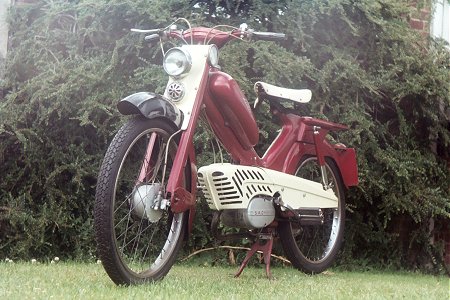
The brakes were fairly effective, though operation of the front was made particularly unpleasant as the bike reared up on its suspension, and the wheel slewed over due to slack in the leading link pivots.
The Sachs engine is fitted with a Bosch flywheel mag lighting set rated at the same 6 Volt, 17 Watt output as the preceding Villiers generator - and no, you still aren't going to need your sunglasses to withstand the dazzling glare from the headlamp!
The 45mph VDO speedo delivered fairly comparable indication to our pace bike readings.
Being fitted with a cycle type saddle certainly didn't rate highly in the rider comfort stakes, and while Achilles' idea of turning the saddle mounting post into the horizontal plane may help to make the mountings less inclined to slip, it completely fails to allow for any saddle height adjustment. Consequently, the upper rear location of pedal crank centre on the Sachs engine produces an uncomfortably cramped riding position. This effect was less apparent on the Villiers Lido due to the pedal crank centre being lower and further forward in the 3K engine design.
The Nippy Mark 3 was re-listed in the 1961 sales season, as was the Super Lido, until all the Sachs motors were built out and the models were officially discontinued later in the year.
In April 1961, forthcoming closures were announced of Norman at Ashford, Sun Cycle & Fittings Phoenix Works at Aston Brook St, J B Brooks in Great Charles Street, Birmingham, and Wrights Saddle Company of Dale Road, Selly Oak. Plans were outlined that all British Cycle Corporation group production of mopeds, scooters, motor cycles, saddle work & luggage from Brooks and Wrights was to concentrate in a new motorised division to be based at the Downing Street, Britannia Works. This former home of Brampton Fittings had been re-occupied by Hercules and James Cycles from 2nd January 1959, as they moved from the old site at Aston, then further joined as office for Aberdale as the Edmonton factory closed in February.
Former Raleigh Sales Manager, David Denny, revealed in interviews to IceniCAM, that the Norman Works had also been under consideration as base for centralisation of the motorised division, but was not chosen.
Market listings for July 1961 find prices for the Norman Nippy Mark 3 dramatically slashed to just £42 in some inviting discount to clear remaining stocks of this model at the end of the main sales season.
Charles and Fred Norman retired, and the Ashford Works closed its doors for the last time on 30th August 1961.
In September 1961, the group introduced new Norman branded Nippy Mark 5 and Lido Mark 3 Motobécane engined models based upon the existing Raleigh RM4 & RM5 machines. These were unrelated, badge-engineered models, assembled by the Motorised Division from Raleigh's own base at Lenton Boulevard, Nottingham, and were dropped from listings in autumn of 1963, to conclude the Norman brand.
The earlier announcement of relocation for all group mopeds, scooters and motor cycles production to the Downing Street, Britannia Works in Birmingham never happened!
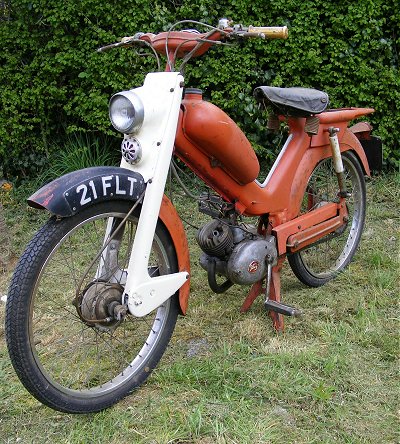
'Unlisted' late model Norman Lido
Glass's Index simply indicates the Norman Nippy Mk3 and Super Lido models as "discontinued 1961", though a small number of 'unlisted' Villiers 3K engined Norman Lidos re-appeared in late 1961 - early 1962, seemingly to use up remaining Lido frame stocks after the last Sachs engines were exhausted.
Gone were all the stylish engine covers of the original model. These final Lidos wore only a simple chain guard and seemed little more than the basic Nippy Mark 4 with a fitted petrol tank.
A number of characteristic features unquestionably confirm these unlisted Lidos as genuine late production machines, and certainly unconnected with the original 1959 batch. A plastic badge on the left hand mag cover clearly indicates the motor as a 3K/1 version, which Villiers only introduced in 1961. The headlamp nacelle displays an extended horn binnacle, a feature brought in from a new moulding tool, and not appearing on Norman moped models until the 1961 season.
Registered in February 1963, frame number AU5609 illustrates an example of this last of the Lidos, which following closure of the Norman Works at the end of August 1961, may have been assembled in Nottingham from leftover parts.
Within just five years, Achilles' Moped of the Future had become The Moped of the Past!
The Norman Nippy Mark 4 continued on listings into the next year to clear remaining stocks, to be finally recorded by Glass's as discontinued in May 1962, at frame number E15527.
This wasn't quite the end of the Lido trail however. There was nearly one last unwritten chapter as rumours of a Raleigh RM3 prototype, but none survives - or do they?
That might be a mystery for some other day!
Next - From our launch as tiny club based section webzine in March 2007, in less than three years, the meteoric uptake of IceniCAM now seems to have catapulted us to a global phenomenon, with a following from all over the world. The sphere of material production has dramatically expanded beyond our original East Anglian base, but would anyone have thought that article generation might become international within less than three years? Drawn by no more than an old photograph that was taken on the Raleigh stand at the first New Zealand International Trade Fair, held in Wellington from August 22nd to September 9th 1961, could we imagine finding ourselves travelling to the far side of the Earth in search of a moped that doesn't officially exist? This may sound like some Conan Doyle adventure fiction, but what if it really may be true?
Even as you may be reading this in the first week of the New Year 2010, the research team should be on their quest. Will they return with a tale to tell? Can we present this in time for the next edition in April?
If you think this may be impossible, then an article called Green Machine will appear in April.
But if you believe... if you really believe... then edition 13 will take us to World's End, and Green Machine slips back to July.
[Text and photos © 2010 M Daniels. Period documents from IceniCAM Information Service.]
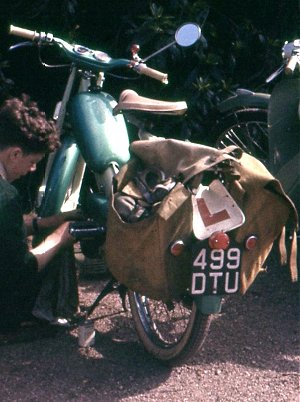
Hello Icenicam,
Enjoyed reading your Achilles feature. Usual thorough research was much appreciated and most welcome in the case of this mostly ignored marque.
A Lido was my first powered two-wheeler, bought in late October 1958. I had seen the model earlier in a Curry's store, it immediately appealed to my youthful eyes, but the one I actually bought came from a mainstream motor cycle dealer and was already registered (499 DTU, Cheshire issue, Sept '58 on) with a very small mileage recorded. Quite why it remained with its original purchaser for so little time I don't know; nor did it occur to me then to find out why. It was quite simply 'as new'.
All of which leads me into saying that not all Achilles Lidos had inverted handlebar levers. This one certainly didn't, as you can hopefully detect from the iffy coloured-snap now attached. I have always believed that these controls were by Magura, but I could be mistaken at this distance in time.
My ownership practically coincided with the news of the Norman reincarnation at Earls Court. That had the then new Villiers motor of course and the modified engine cowling. Must say, I never liked the punched-out pressing, it definitely cheapened a previously quality job.
Your test findings of the Sachs-engined Lido's paces were spot on. I recall a top speed on the VDO speedo (I never had a clock, just the blanking plate) of 33mph, with a cruising speed on the flat of 29/30. My best-remembered average being 27mph in an hour along the Chester road on the way home from North Wales.
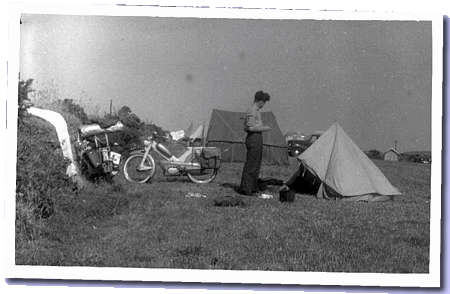
Generally, the machine was without fault, most problems occurring due to my inexperience and lack of regular maintenance (scarcity of cash the culprit). It ran me to work daily, on weekends away and, in August 1959, a fortnight's camping holiday down to Land's End from Cheshire along with a friend on a Quickly "S". We covered 1,000 miles in that two weeks and I learned (very necessary, as it lost most of its power) how to decoke an engine on a camping field! Another iffy photo (b&w) is also attached, taken at Sennen Cove near Land's End.
All in all, it was a great intro to a lifetime of motor cycling, so you can see, your feature jogged my memory.
In recent years I have tried to locate original press material on the Achilles out of interest, just as you have done now. I have all the mentions you have also come by, but nothing more so far. Although, I do recall reading a piece at the time in which it was stated that the Lido design was the work of a famous Italian automobile styling house, but that isn't mentioned in any of the assembled literature I have now. I think the stylist was Ghia, but until I come across that article I can't prove it. Small things occupy ageing minds, don't they?
Thanks again for the memories.
Ken Hallworth
PS, I still have the hair, prominent in the colour piccy; rather shorter maybe, oh yes, and the colour has changed!
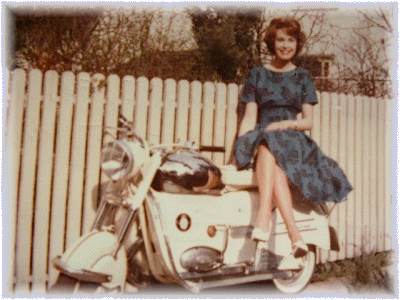
Achilles (Ami-Sport) Roller
Hi,
Just scanning the web for info on a bike I used to own.
Attached a picture taken in 1957 in Switzerland, with my bike and then girlfriend, now wife of 50 years. I owned two of these machines, both bought in Zurich brand new, one involved in a high-speed accident that left me 13 months in hospital (wrapped around a metal lamp-post after a party!) and the next one, the one in the picture, bought not long after being OK again, totally stripped down, painted with ten coats of baking enamel in hard white, a light blue seat and chrome tank. Remember this was a brand-new bike, and the work done was purely for fun!
This machine turned many, many heads in the city of Zurich, and I sold it in 1959 before emigrating to New Zealand. I have not returned back to Europe since then.
By the way, this bike was then sold in Zurich under the name Ami-sport.
Kind Regards,
Alfred Chiodera
Queensland, Australia
I enjoyed your report on the Super Lido moped.
As a schoolboy I bought one for £50 secondhand. It was metallic green and cream, had white wall tyres and very striking visually. It often drew a crowd when parked.
The Sachs fan-cooled engine pulled well even when a friend was on the long comfortable pillion seat. The three well spaced gears allowed a cruising speed in excess of 30mph and it climbed hills well.
As the article adds, the front suspension allowed the wheel to cant when the rider braked. In my case this caused the axle to break but I became quite adept at changing it.
Unfortunately, a car pulled out in front of me when I was going down a hill and it was written off. I used the engine in a Norman Nippy frame for a few more years.
John Silvester.
John's letter throws up some interesting points. He says his Norman had a three-speed fan-cooled engine and, as far as we know, Norman never fitted this engine to their Lido mopeds. Similarly, a dual seat was not the normal fitting for a Norman. The dual-seat and the metallic green and cream colour scheme were, however, available on Achilles versions of the Lido. Maybe John's Lido was actually an Achilles? And, as it happens, we do know of one Achilles Lido that has a fan-cooled engine...
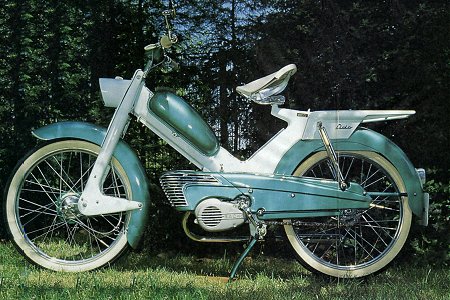
Achilles Lido with fan-cooled engine
This Lido main feature had been slowly trundling down the conveyor belt for some time, before the decision was finally made that its number was due to be counted.
The research file first started developing around late 2007, and it became clear, right from the beginning, that the background on Achilles was going to be pretty difficult since there was very little published information out there. Achilles research had to focus on tracking down mostly continental references, and various translations from Dutch and German were handled by Ben Teuben, Ronny Schmidt, and Lutz Friedrich.
The science fiction, futuristic styling of the Lido gave us the theme for the article presentation and its title - Back to the Future.
The first text draft was assembled over Easter of 2008, being one of several articles penned about this time. Along with the Atco Trainer presentation, and James Comet feature Fly Me, this was yet another product of the infamous 'Mauritius Batch'. A busted cartilage three days beforehand reduced the transit flights to a wheelchair to progress through the airport system, and time on the island limited to crutches. While not being up to chasing Dodos along the beaches, it certainly created plenty of time for writing, so what wasn't too good for the author, worked somewhat in favour of the IceniCAM readership.
Trying to track down and piece together the Achilles origins was a vague and slow process, and was one of the main hindrances to forward progress - the other problem was trying to find Lidos! They're not a particularly common moped, and surviving examples often seem in poor condition and incomplete. The side panels and engine cover are frequently missing, which wouldn't have been particularly suitable for presentation of our article, since these parts characterise the whole ethos of the design.
Presentation of the text followed a markedly different slant, tracking the Lido trail through its history with two different companies, beginning with Achilles in Bohemia, through to the Norman Cycle Company at Ashford in Kent.
We did locate a couple of Achilles Lidos, but neither in suitable condition to include in this article... maybe some other time as a mini-feature. Then Mick Spacey magically started turning up a series of Norman Lidos as if they were a common find in his patch of the Thetford forest! Having access to test feature Mick's first blue & white 3K Lido was the breakthrough to get the article progressing, followed by his maroon & cream Super Lido. While this second machine generally looked in presentable condition, with correct and original finish, it was missing the original side panels and engine cover, and the motor proved incapable of road test.
The photoshoot was accomplished by borrowing a set of panels from another dismantled Super Lido belonging to Martin Gates, and so at least we managed to bag a good set of pictures from this temporary assembly of all the correct parts.
We'd known the late 'unofficial' 3K model of Kevin Grimwade for some time, so this bike became the third photoshoot to complete all the pictures for the feature.
This just left us wanting another Super Lido to complete the road test element, and again, Mick turned up yet another Super Lido, which was sold on to Josh Ward, and subsequently made roadworthy - the last piece of our jigsaw. Being refinished in unofficial red & white colour scheme eliminated this bike from inclusion in the article pictures, but finally provided a suitably running Sachs engined example for the road test element, so that completed the full set, and the article was finally on.
Sorting out the complexity and chronology of Norman's respective moped models took a considerable amount of research, the confusing detail of which probably explaining why nobody's really presented this as such a complete entity before. Though this information may not prove everyone's most appealing reading, its publication was included for a useful point of reference.
Producing the Lido article proved such an epic project over a two-year period, it just had to go out as a main feature by the time it finally ran to the finishing tape. The effort does, however, seem worthwhile, now it should establish the most comprehensive reference work presented on the Lido.
The amount of running around involved in collecting and returning bikes for the various photoshoots and tests racked up the fuel bill, with the feature finally costing £45 to produce. Thanks to IceniCAM reader Errol Bristow from Watton, Norfolk, who scores the sponsorship credit.